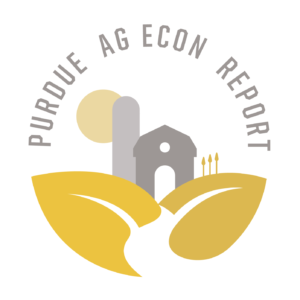Soybeans Pay Bills With Friendly Price Tone
December 16, 2017
PAER-2017-23
Author: Chris Hurt, Professor of Agricultural Economics
Soybeans have generally been superior to corn in paying the bills in recent years. Yields have been strong and the opportunity to sometimes price at $10 a bushel or higher has provided strong revenue, plus direct costs for beans are much lower than for corn.
National soybean yields were 49.5 bushels per acre for the 2017 crop, well above trend, but down 2.5 bushels from the 2016 record. In Indiana, yields were a strong 55 bushels, but down 2.5 bushels from the 2016 record.
The USDA estimate of the U.S. marketing year average (MYA) price at $9.30 is down from $9.47 for the 2016 crop. Indiana farmers averaged selling their 2016 crop at $9.69 and that could be more like $9.45 to $9.60 for the 2017 crop. Lower Indiana yields and somewhat lower prices will mean lower soybean revenues compare to the 2016 crop.
While corn prices are buried under large inventories, soybeans are in better shape. Increased purchases this marketing year from China, or reduced yields in South America could both provide soybean price recovery. The current LA Nina weather pattern is expected to continue through the winter and into spring. LA Nina’s have a tendency to cause dry weather in Argentina and that is now the case. Argentina is the third largest soybean exporter, but the largest exporter of meal and oil products. Reduced production there would stimulate U.S. soybean and product ex- ports.
Like the corn market, soybeans have sizable price premiums for delivery into the late spring and early summer. The July futures are about $.30 higher than the January and basis appreciation may be about $.20. This means the potential to earn about $.50 higher prices for delivery into early next summer.
The objective is to price beans for delivery into early summer starting with the July 2018 futures around $10.30 to $10.40 a bushel and then adding more bushels around $10.60. This will provide cash prices over $10 for early summer delivery. At this writing, July futures had reached this initial level. It may be important to have specific price thresholds in mind. When markets have large inventories, prices may touch objectives and back down quickly.
Unfavorable weather in South America would likely have more upward price impact on soybeans than corn. World yields have been strong for corn, soybeans and wheat over the past four years. Some would argue the world is due for a production setback. Just the potential for lower yields will probably help support soybean prices into the winter.
New crop soybean prices once again seem to suggest that market prices are bidding for more soybean acres and less corn and wheat. Somewhat higher U.S. acreage in soybeans in 2018 will moderate price recovery for 2018 crop beans. Nevertheless, even with this anticipation, futures markets are suggesting 2018 soybean prices will be $.30 to $.40 higher than the 2017 crop.
